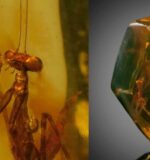In a remarkable natural process, insects and even mammals can be preserved in time for all eternity by becoming encased in tree sap that eventually turns into amber.
In the hit movie Jurassic Park, a scientific character was able to draw dinosaur blood from mosquitoes imprisoned in amber, drawing attention to and popularizing this true phenomena.
A little praying mantis that was found in a piece of amber in 2016 was sold by Heritage Auctions for $6,000 in pristine condition.
Somewhere in the Dominican Republic, the amazing object was found. According to Heritage Auctions, this object is thought to be from the Oligocene epoch, making it somewhere between 23 million and 33.9 million years old. The auction description from a related sale reads as follows:

“The Praying Mantis, one of the rarest and most prized inclusions of all, is present in this specimen. Due to their terrified fight to escape the relentless ooze, these aggressive insects are typically deformed or without limbs when discovered.
The color patterns on this specimen’s short legs, tiny arm spikes, delicate antennae, and enormous, complex eyes are all perfectly maintained, though.
The bug, which is around 12 inches long and is enclosed in a gorgeous polished golden nugget that measures 134 by 114 by 1 inch, is a remarkable example of ancient life. The item is particularly impressive since it also includes three sizable, well-preserved click beetles, making it a museum-quality specimen.
Similar methods can be used in Amber to preserve animals. Researchers discovered a newborn snake’s preserved bones last year that they estimated to be 99 million years old.
One of the scientists who examined the snake specimen is Michael Caldwell, a professor in the biological sciences division at the University of Alberta in Canada. The specimen was given the name Xiaophis myanmarensis by Caldwell and his team.
“Despite being a young snake, it has highly distinctive characteristics on the top of the vertebrae that have never been observed in any fossil snakes of its species.
According to Caldwell, Xiaophis belongs to a group of snakes that appear to be extremely old near the base of the snake family tree.
“Amber gathers whatever it comes in contact with, acting almost like super glue, and keeps it for a hundred million years. It is obvious the snake was living in a forest because, when it captured the young snake, it also caught the forest floor with the bugs, plants, and insect dung, the man stated.








 Photographer Finds Locations Of 1960s Postcards To See How They Look Today, And The Difference Is Unbelievable
Photographer Finds Locations Of 1960s Postcards To See How They Look Today, And The Difference Is Unbelievable  Hij zet 3 IKEA kastjes tegen elkaar aan en maakt dit voor zijn vrouw…Wat een gaaf resultaat!!
Hij zet 3 IKEA kastjes tegen elkaar aan en maakt dit voor zijn vrouw…Wat een gaaf resultaat!!  Scientists Discover 512-Year-Old Shark, Which Would Be The Oldest Living Vertebrate On The Planet
Scientists Discover 512-Year-Old Shark, Which Would Be The Oldest Living Vertebrate On The Planet  Hus til salg er kun 22 kvadratmeter – men vent til du ser det indvendigt
Hus til salg er kun 22 kvadratmeter – men vent til du ser det indvendigt  Superknepet – så blir snuskiga ugnsformen som ny igen!
Superknepet – så blir snuskiga ugnsformen som ny igen!  Meteorite That Recently Fell in Somalia Turns Out to Contain Two Minerals Never Before Seen on Earth
Meteorite That Recently Fell in Somalia Turns Out to Contain Two Minerals Never Before Seen on Earth  Nearly Frozen Waves Captured On Camera By Nantucket Photographer
Nearly Frozen Waves Captured On Camera By Nantucket Photographer  It’s Official: Astronomers Have Discovered another Earth
It’s Official: Astronomers Have Discovered another Earth 